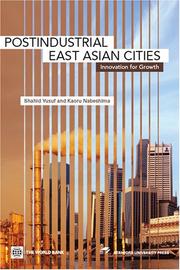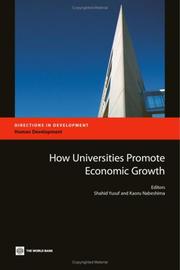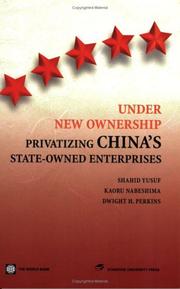| Listing 1 - 9 of 9 |
Sort by
|

ISBN: 0804756724 0821356224 9786610564514 1280564512 0821366491 9780821356227 9780804756723 9780821366493 Year: 2006 Publisher: Palo Alto, CA : Washington, DC : Stanford Economics and Finance ; World Bank,
Abstract | Keywords | Export | Availability | Bookmark
 Loading...
Loading...Choose an application
- Reference Manager
- EndNote
- RefWorks (Direct export to RefWorks)
Post-Industrial East Asian Cities analyzes urban developments and policies responsible for the growth of producer services and creative industries. This study is based on the findings of firm surveys conducted in East Asia and a review of the data and literature on several key regional cities (Beijing, Shanghai, Singapore, Seoul, Bangkok and Tokyo) that are transitioning away from traditional manufacturing activities.
Cities and towns. --- Cities and towns --- Service industries --- Technological innovations --- Sociology & Social History --- Social Sciences --- Communities - Urban Groups --- Economic aspects --- #SBIB:39A4 --- #SBIB:39A75 --- #SBIB:316.334.5U20 --- Industries --- Global cities --- Municipalities --- Towns --- Urban areas --- Urban systems --- Human settlements --- Sociology, Urban --- Toegepaste antropologie --- Etnografie: Azië --- Sociologie van stad (buurt, wijk, community, stadsvernieuwing) --- East Asia --- Asia, East --- Asia, Eastern --- East (Far East) --- Eastern Asia --- Far East --- Orient --- Economic policy. --- Economic conditions

ISBN: 1280725605 9786610725601 0821367528 082136751X 9780821367513 Year: 2006 Publisher: Washington, DC : World Bank,
Abstract | Keywords | Export | Availability | Bookmark
 Loading...
Loading...Choose an application
- Reference Manager
- EndNote
- RefWorks (Direct export to RefWorks)
With technological capability increasingly becoming the touchstone of competitiveness in an open and integrated world environment, the role of universities in economic growth is taking on a greater salience. Not only do they impart education but also they are coming to be viewed as sources of industrially valuable technical skills, innovations and entrepreneurship. Realizing this potential of universities so as to spur growth is now a priority in developed and developing countries. This calls for coordinated policy actions. The distinguished contributors to this volume examine the wealth of in
Business and education --- Economic development --- Technology transfer --- Education and state --- Effect of education on --- Academic-industrial collaboration --- -Business and education --- -338.4 --- Corporations and education --- Industry and education --- Education and business --- Education and corporations --- Education and industry --- Worksite schools --- Collaboration, Academic-industrial --- Collaboration, Industrial-academic --- Industrial-academic collaboration --- Industrial-university collaboration --- University-industrial collaboration --- Industrie et éducation --- Effets de l'éducation sur --- Développement économique --- Transfert de technologie --- Education --- Congresses. --- Congrès --- Politique gouvernementale
Book
ISBN: 0821365096 9780821365090 082136510X 9780821365106 9786610447534 1280447532 Year: 2006 Publisher: Washington, DC : World Bank,
Abstract | Keywords | Export | Availability | Bookmark
 Loading...
Loading...Choose an application
- Reference Manager
- EndNote
- RefWorks (Direct export to RefWorks)
Over the past two decades China's growth has been rapid, social indicators have improved, and poverty levels have inched downward. However,widening inequality, increasing resource and financial imbalances, and growing environmental concerns provide China with daunting challenges in improving the quality of growth. The rapid growth that will remain China's principal vehicle for raising standards of living and reducing poverty will derive from urbanization, increased market efficiency, and improvement in the technological capability of Chinese firms. But although growth will be critically import
Economic policy and planning (general) --- China --- Chine --- Economic policy. --- Economic conditions. --- Politique économique --- Conditions économiques --- Economics. --- Economic theory --- Political economy --- Social sciences --- Economic man --- S10/0251 --- China: Economics, industry and commerce--General works and economic history: since 1989
Digital
Abstract | Keywords | Export | Availability | Bookmark
 Loading...
Loading...Choose an application
- Reference Manager
- EndNote
- RefWorks (Direct export to RefWorks)
Digital
ISBN: 0821365096 9780821365090 082136510X 9780821365106 Year: 2006 Publisher: Washington, D.C. World Bank
Abstract | Keywords | Export | Availability | Bookmark
 Loading...
Loading...Choose an application
- Reference Manager
- EndNote
- RefWorks (Direct export to RefWorks)

ISBN: 0821356240 0821356259 9780821356241 0804753903 080475389X 9786610253593 1280253592 Year: 2006 Publisher: Palo Alto, CA : Stanford University Press,
Abstract | Keywords | Export | Availability | Bookmark
 Loading...
Loading...Choose an application
- Reference Manager
- EndNote
- RefWorks (Direct export to RefWorks)
Although China's centrally planned economy is a little more than a shadow of its former self, the closely inter-linked reforms of the enterprise and banking sectors are still incomplete. The relative size of the state-owned enterprise sector has been much reduced, however, the sector remains the dominant borrower from the banking system and is responsible for the majority of bank non-performing assets. Thus in the interests of financial stability it is crucial to implement the remaining reform agenda. The accession to the WTO has also made it more urgent for China's most-dynamic state-owned en
Economic order --- Economic policy and planning (general) --- Public economics --- China --- Government ownership --- Privatization --- S10/0520 --- S10/0580 --- S10/0582 --- S10/0583 --- China: Economics, industry and commerce--Industry: since 1949 --- China: Economics, industry and commerce--Management of enterprises (general, theories) --- China: Economics, industry and commerce--Management of collectives --- China: Economics, industry and commerce--Management of private enterprises

ISBN: 0821356240 0821356259 9780821356241 0804753903 080475389X Year: 2006 Publisher: Washington, D.C. World Bank
Abstract | Keywords | Export | Availability | Bookmark
 Loading...
Loading...Choose an application
- Reference Manager
- EndNote
- RefWorks (Direct export to RefWorks)
Economic order --- Economic policy and planning (general) --- Public economics --- China
Book
Year: 2006 Publisher: [Washington, D.C. : World Bank,
Abstract | Keywords | Export | Availability | Bookmark
 Loading...
Loading...Choose an application
- Reference Manager
- EndNote
- RefWorks (Direct export to RefWorks)
"Since the early 1980s, China has begun gradually integrating with the global system. In doing so the country has moved toward its own unique brand of market socialism, which recognizes private ownership, and is adopting market institutions and pursuing industrial change within the framework of an urban economic environment. The process of transition has now permeated every corner of Chinese life and no organization has been left untouched. Yet industrial organization in China-especially in the state sector-has been slow to shed many of the distinctive structural characteristics of the old line Maoist era state enterprises. The main prong of the industrial strategy in support of urban change is ownership reform that transforms state-owned enterprises into corporate entities with majority state ownership or places them wholly in private hands, in the process also bolstering the incentives for and the dynamism of the private sector. While the central government spearheads the ownership reform initiative, in the majority of cases the actual implementation is in the hands of municipal, county, and prefectural governments that must coordinate their efforts with other factors influencing urban changes. This paper situates industrial change in China within the context of urban development and examines the interplay of broad reform strategy with local implementation, and its actual practice by the reformed firms. "--World Bank web site.
Capitalism --- Globalization. --- China --- China --- Economic policy --- Foreign economic relations.
Book
Year: 2006 Publisher: [Washington, D.C. : World Bank,
Abstract | Keywords | Export | Availability | Bookmark
 Loading...
Loading...Choose an application
- Reference Manager
- EndNote
- RefWorks (Direct export to RefWorks)
"Since the early 1980s, China has begun gradually integrating with the global system. In doing so the country has moved toward its own unique brand of market socialism, which recognizes private ownership, and is adopting market institutions and pursuing industrial change within the framework of an urban economic environment. The process of transition has now permeated every corner of Chinese life and no organization has been left untouched. Yet industrial organization in China-especially in the state sector-has been slow to shed many of the distinctive structural characteristics of the old line Maoist era state enterprises. The main prong of the industrial strategy in support of urban change is ownership reform that transforms state-owned enterprises into corporate entities with majority state ownership or places them wholly in private hands, in the process also bolstering the incentives for and the dynamism of the private sector. While the central government spearheads the ownership reform initiative, in the majority of cases the actual implementation is in the hands of municipal, county, and prefectural governments that must coordinate their efforts with other factors influencing urban changes. This paper situates industrial change in China within the context of urban development and examines the interplay of broad reform strategy with local implementation, and its actual practice by the reformed firms. "--World Bank web site.
Capitalism --- Globalization. --- China --- Economic policy --- Foreign economic relations.
| Listing 1 - 9 of 9 |
Sort by
|

 Search
Search Feedback
Feedback About UniCat
About UniCat  Help
Help News
News